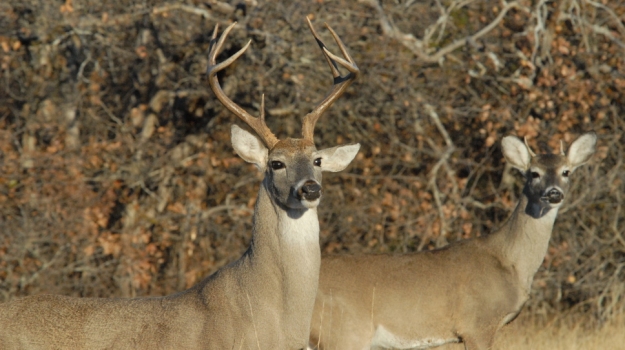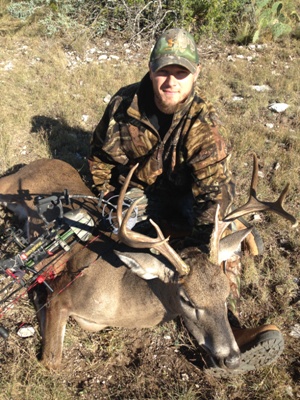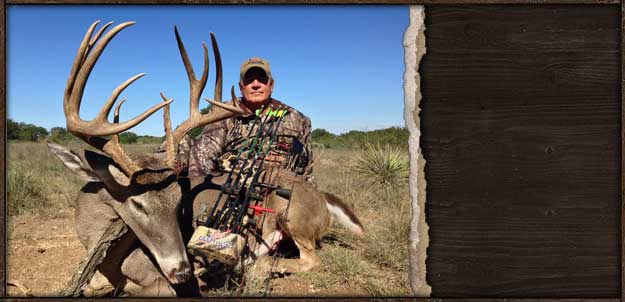
Editor’s Note: Kevin Burleson has owned Heart of Texas Bowhunting for 13 years, 16-miles west of Brady, Texas. Geographically it’s right dead center in the middle of Texas. He's been a Mossy Oak Pro Staffer for 10 years and is one of the Mossy Oak Deer Thugs on the TV show on the Pursuit Channel. A bowhunter since he was 19-years old, he's also a member of the PSE Pro Staff. “I've been wearing Mossy Oak camouflage as along as Mossy Oak has been making Mossy Oak camouflage,” Burleson says. Can you imagine seeing 30 to 40 bucks each day that you hunt? The deer-management system that Kevin Burleson uses may not produce this type of results on other properties in the U.S. However, this management system works for Burleson in Texas.
Many people who hunt with us don’t understand how to stalk to and stalk away from their blinds. They're in a big hurry to get to their blinds and get ready to take a buck, however they may spook trophy bucks they would have loved to have taken with their bows. One of the best tips I give to a bowhunter is that anytime you're moving through the woods, move two notches down from slow and then move super slow. Remember every step you take, you have a totally-different view of everything around you. Being able to see an animal before the animal spots you is the only way you'll harvest an animal when you're walking.
In Colorado before, I've walked up into the middle of a herd of bedded elk. I didn’t even realize that I'd walked past six or seven elk that I didn’t see, until I turned around to look. Moving super slow and steady all I’d see was a patch of brown and didn’t recognize it as an elk. This is the same way I walk when we’re hunting in Texas. I advise my bowhunters to take a step or two. Then turn slowly and look 360 degrees from where they have their feet planted. Remember every step you take, you get a completely-different view of everything in front of you, beside you and behind you. Even when going to their stands before daylight, we advise our hunters to walk extremely slowly and to only use red light flashlights. Actually we prefer red light flood lights instead of spot lights. Many times if our hunters are walking slowly enough, they’ll walk right past deer that are bedded close to their blinds. We won’t let our hunters start their vehicles before 10:30 in the morning, and I suggest that hunters don’t leave their blinds until 11:00 am.
We have a problem here in central Texas that’s somewhat unique compared to other parts of the country. We have a whole lot of deer on our property. On an average morning hunt, our hunters will see 10 to 20 deer. On the afternoon hunt, they’ll see another 10 to 20 deer. Seeing 40 to 50 deer in a single day is not uncommon at all. Most of the time our hunters see more bucks – generally 1-1/2-year olds – than they do does. We intensively manage our deer herds. That’s why our hunters see more bucks than does. We have so-many deer on our lands that we have to cull a lot of deer – bucks with undesirable genetics or does when we see that we have too-many does on the property. This section of Texas is extremely saturated with miles and miles and miles of deer. I'm pretty sure that we take more deer off the 8,000 acres we manage than all my neighbors do.
 Every year before deer season begins, we do night spotlight deer surveys. During those surveys, we determine how many deer we need to take off the land during the upcoming season to try and keep our herd in balance. We also attempt to learn the age structure of the deer we survey. Even though we take off a large number of deer from our property, every year when we do our light surveys, we still have the same number of deer on the land that we’ve had at the beginning of the season during the previous year.
Every year before deer season begins, we do night spotlight deer surveys. During those surveys, we determine how many deer we need to take off the land during the upcoming season to try and keep our herd in balance. We also attempt to learn the age structure of the deer we survey. Even though we take off a large number of deer from our property, every year when we do our light surveys, we still have the same number of deer on the land that we’ve had at the beginning of the season during the previous year.
Each season we take between 200 and 350 does, which doesn’t include the number of cull bucks that we take. I'm a little more conservative on shooting cull bucks than most ranchers. I won’t declare a buck a cull buck until he's at least 3-1/2-years old, regardless of what his antlers look like. The exception is if I see a 2-year-old long-horn spike, and I know we need to harvest more deer than we've been harvesting. Then we’ll let a hunter take that buck. Most often, we determine a cull buck as a buck that has 7 points or less and is 4-years old or older.
We've determined that some years our deer just don’t get enough nutrition to produce large antlers. If we’ll let that buck go another year until he’s 3-1/2- to 4-years old, he may get better nutrition and produce better antlers. We’ve learned not all bucks that have little antlers are genetically inferior deer, even if that deer is 3- or 4-years old. We carry so many older-age-class bucks on our property that they're not going to let those younger bucks breed anyway. We want to make sure we keep the number of deer on the property low enough, so that there’s plenty of food available to allow our bucks to grow large racks and have numbers of bucks for our hunters to see.
I have a friend who’s a wildlife biologist. Every year, he comes to our ranch and tells us how much nutrition our plants have in them. He also tells us about how many deer we need to have per acre to keep the nutrition level high enough to feed all the deer on the property. Every year, our hunters will take some bucks that score 150 to 160 on Boone & Crockett. The neighboring properties to our ranch will only take bucks that score 130 B & C or less. So, we know that our deer-management program is producing some of the best bucks we can. This management program starts with removing the surplus of deer every year. Each year, we’ll take from 200 to 400 does off 8,000 acres. Depending on the year, we’ll take 50 to 100 bucks, including cull bucks as well as mature bucks. I think the real secret to our management system is removing a large number of deer each season and keeping our ranch a sanctuary for deer.
To see what Heart of Texas Bowhunting’s management is producing, click here. You can check out the Heart of Texas Bowhunting facebook page at www.facebook.com/heartoftexasbowhunting.
Day 1: Deer THUG Kevin Burleson Gives Tips for Better Deer Bowhunting
Tomorrow: Kevin Burleson Tells Why His Ranch Is a Deer Sanctuary






























